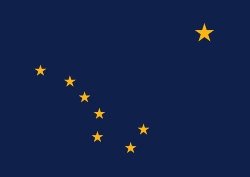Top Qs
Timeline
Chat
Perspective
Alaskan Russian
Russian of southwestern Alaska From Wikipedia, the free encyclopedia
Remove ads
Alaskan Russian, known locally as Old Russian, is a dialect of Russian, influenced by Eskimo–Aleut languages, spoken in what is now the U.S. state Alaska since the Russian colonial period. Today it is prevalent on Kodiak Island and in Ninilchik (Kenai Peninsula), Alaska; it has been isolated from other varieties of Russian for over a century.[1]
Remove ads
Dialects
Kodiak Russian was natively spoken on Afognak Strait until the Great Alaskan earthquake and tsunami of 1964. It is now moribund, spoken by only a handful of elderly people, and is virtually undocumented.[2]
Ninilchik Russian is better studied and more vibrant; it developed from the Russian colonial settlement of Ninilchik in 1847.[3][4]
Vocabulary
Summarize
Perspective
Ninilchik Russian vocabulary is distinctly Russian, with a few borrowings from English and Alaskan native languages.

Below is a comparison between some examples of Alaskan Russian from the village of Ninilchik and modern standard Russian, using a transcription of modern Russian that follows the same scheme (including vowel reduction, which is not marked in the standard Russian orthography). As in standard Russian, most consonants also have a palatalized (or 'soft') form, which is marked by an apostrophe, as in ⟨nʹ⟩. Words with multiple syllables have stress marked with an acute accent.[4]
Remove ads
References
Wikiwand - on
Seamless Wikipedia browsing. On steroids.
Remove ads

